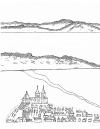Abstract
The material and spiritual necessity to bury corpses in Córdoba del Tucumán, not only in the period of Spanish dominion, but also after independences, implied the development of a series of burial costums, similar to the ones which were fulfilled in the rest of the New World. In the XVI, XVII and XVIII centuries, burials were done inside churches or in neighboring cemeteries, in certain spaces that acquired a singular meaning in relation to “the further on”. During the Seven hundred, the Borbones impelled the construction of cemeteries in open places, what took shape in the city in mid-XIX century, when de plague forced to accelerate the burials. The information required by the monarchs to the respective authorities, contain a series of constructive specifications that show the architectonic and economic conception that they elaborated.Apuntes is registered under a Creative Commons Attribution 4.0 International Public License. Thus, this work may be reproduced, distributed, and publicly shared in digital format, as long as the names of the authors and Pontificia Universidad Javeriana are acknowledged. Others are allowed to quote, adapt, transform, auto-archive, republish, and create based on this material, for any purpose (even commercial ones), provided the authorship is duly acknowledged, a link to the original work is provided, and it is specified if changes have been made. Pontificia Universidad Javeriana does not hold the rights of published works and the authors are solely responsible for the contents of their works; they keep the moral, intellectual, privacy, and publicity rights.
Approving the intervention of the work (review, copy-editing, translation, layout) and the following outreach, are granted through an use license and not through an assignment of rights. This means the journal and Pontificia Universidad Javeriana cannot be held responsible for any ethical malpractice by the authors. As a consequence of the protection granted by the use license, the journal is not required to publish recantations or modify information already published, unless the errata stems from the editorial management process. Publishing contents in this journal does not generate royalties for contributors.


